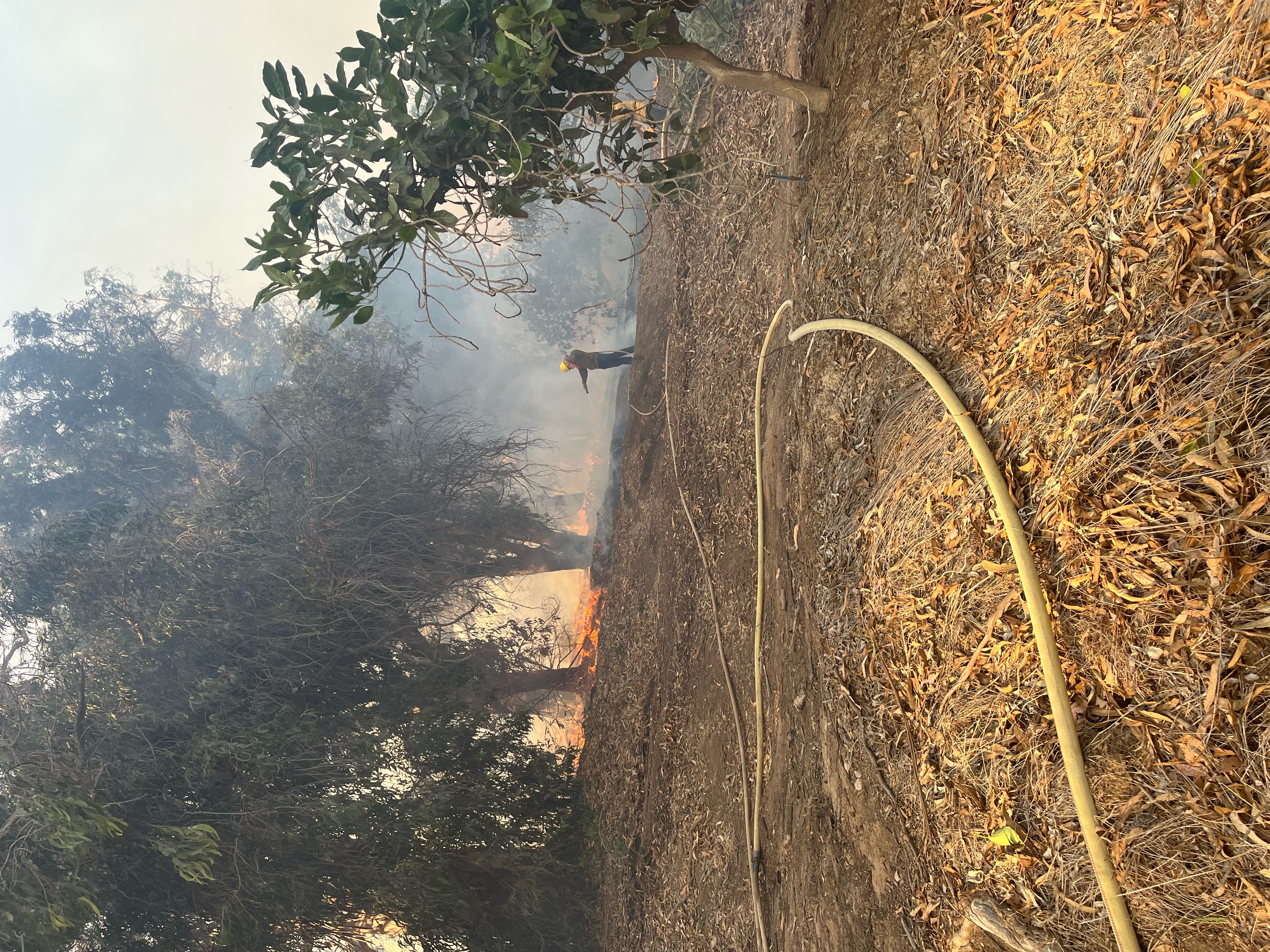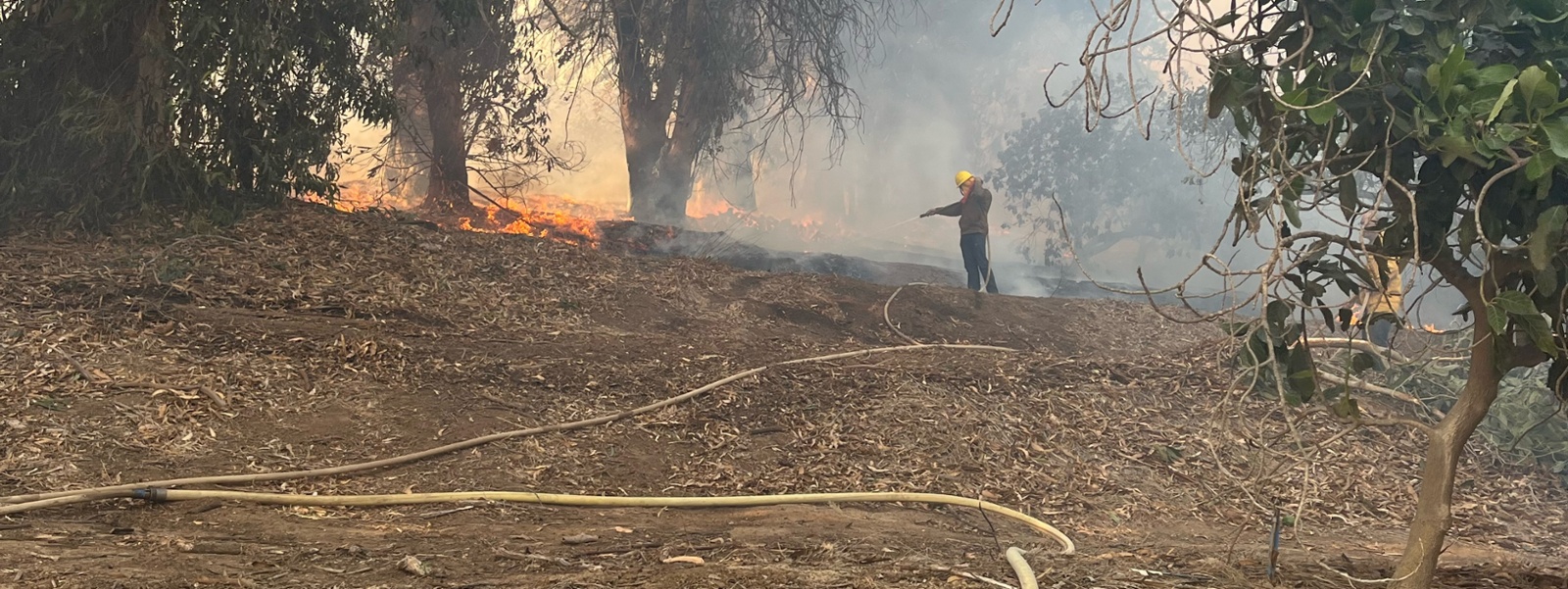Farmers fought fire as insurers left homes at risk

Off-duty firefighter Aric Duran works to slow the progress of the Mountain Fire as it burns through the Atchley family’s ranch in Somis on Nov. 6.
Photo/Nicholas Atchley

By Caleb Hampton
At around 9 a.m. on Nov. 6, Nicholas Atchley was in a meeting at his office when he received a text message saying a fire was sweeping through a canyon near his family’s lemon and avocado groves in the Ventura County community of Somis.
Atchley drove straight to the ranch. His family, which has farmed in the county for close to a century, bought the 64-acre orchard earlier this year. A promising crop of young avocados—next year’s would-be harvest—was hanging on the trees. At the bottom of the hillside property stood several buildings, including housing for five employees and their families.
The residents evacuated. But the homes, like many homes in parts of California with high fire risk, were uninsured.
“If the fire took out the houses, it would ruin us,” Atchley said.
During the past three weeks, the Mountain Fire has burned some 20,000 acres and destroyed 243 structures, making it Southern California’s third-most destructive fire in the past decade. The fire, which as of Monday was almost completely contained, burned around 12,000 acres of crops and rangeland, according to Ventura County Agricultural Commissioner Korinne Bell.
Hardest hit have been the county’s avocado groves. Roughly a quarter of Ventura County’s 16,497 acres of avocados was in the burn area, according to Bell. As of last week, the county was only beginning to determine the extent of losses, she said. In the portion surveyed so far, 588 acres of avocados were damaged, resulting in losses of more than $4 million. Including damage to citrus, raspberries and rangeland, agricultural losses topped $7 million.
“It’s an area where a lot of people have small orchards and live in homes on the property,” said Maureen McGuire, chief executive officer of the Farm Bureau of Ventura County. Many people were forced to evacuate, she said, with some losing their houses in the fire.
For roughly 24 hours, Nicholas Atchley, joined by his father, Richard Atchley, his uncle and a friend, defended their property from the blaze. Fire engines were parked on the street below, the family said, but as the flames approached, no one appeared to help them.
“We were on our own,” Nicholas Atchley said. “It came fast, and we realized our only option was to try to keep it above the houses, to keep the structures safe.”
With the power cut, they were unable to switch on the orchard’s sprinkler system. So, they attached a fire hose—usually used on the ranch to clean a reservoir—to a 500-gallon water trailer, driving through deserted streets to refill the tank. By noon, flames crested the hillside and began to engulf the trees.
“It kind of came across and moved into our avocados, burning the leaves underneath the avocados,” Richard Atchley said. “It burned straight across and just cooked tons of trees.”
The four men used a skid steer and a mini excavator to tear out a row of lemon trees, cutting a swath of bare land they hoped would starve the fire of fuel and keep it from descending toward the homes.
“When the fire came to that area, we used what water we had to keep it above the fire line,” Nicholas Atchley said. “The fire was right on us.”
He suffered from smoke inhalation, he said, after battling the fire without a respirator or other protective gear. “The next day, I felt like I had sand in my eyes. They were so swollen and painful,” he said. Had the houses been insured, he said, “it would have been better just to stay out of harm’s way.”
McGuire, the county Farm Bureau CEO, said many farmers and homeowners in the county lost their property insurance during the past few years as insurance companies withdrew from the market, deeming it too risky.
When the Atchley family bought the ranch earlier this year, they were unable to find a private company that would sell them insurance. In recent years, a rising number of property owners have resorted to buying policies from California’s FAIR Plan, the state’s insurer of last resort. But FAIR Plan policies are expensive and do not provide comprehensive coverage. The Atchleys were advised they would be better off absorbing the risk on their own.
“Financially, it wasn’t viable to pay for it,” Nicholas Atchley said.
Farm groups have pushed for solutions to California’s insurance crisis while acknowledging it may be a hard problem to solve.
“The state’s ability to regulate insurers does not include just telling them that they must provide insurance to you,” said Peter Ansel, senior policy advocate for the California Farm Bureau. “They don’t have to be here doing business if they’re not making money.”
Changes to California’s property insurance market may be on the horizon. Last year, the California Department of Insurance announced a framework of new policies, called the Sustainable Insurance Strategy, to address the crisis and attract insurers back to the state.
On Nov. 14, the department submitted a regulation—the latest phase of the framework—that would enable insurance companies to use catastrophe modeling to better predict risks. In exchange, the companies would be required to write comprehensive policies in high-risk areas equivalent to at least 85% of those areas’ statewide market share. The regulation, if approved, would take effect Jan. 1.
“We are encouraged the commissioner is working to try to restore access to insurance,” Ansel said. Without it, he added, “people are doing drastic things.”
The Atchley family worked through the night, using shovels and rakes to clear debris away from the flames. By morning, “it basically burned the whole hillside above the houses,” Nicholas Atchley said.
The family succeeded in keeping the blaze above the houses. But they may have lost most of their trees along with almost all of this year’s crops as the flames stripped the trees, burned the fruit and melted their irrigation systems.
Nicholas Atchley estimated the fire damaged all 40 acres of lemon trees and half of the 24 acres of avocado trees on the ranch, though the family was still waiting on a professional assessment of the tree damage. And it wiped out 15 acres of irrigation lines installed in preparation for new plantings.
“To get everything replanted and fixed is not going to happen for years down the road,” Nicholas Atchley said. Because of the financial losses from the fire and the lost harvest, he said, “even buying trees is not an option for us at this point.”
The Atchley’s ranch is one of 140 avocado farms in the burn area of the Mountain Fire, according to Bell, the agricultural commissioner.
“It’s a very significant amount of damage for our avocado acreage,” McGuire said, referring to Ventura County’s production, which leads the nation. The time and money required to establish orchards means it will take farms years to recover.
Bell said nurseries in the area have a two-year wait list for some avocado varieties, which typically take at least three more years after being planted to start producing.
“It’s a long-term investment and a long-term loss when you lose a tree,” she said.
During the past few weeks, the Farm Bureau of Ventura County has hosted webinars encouraging farmers impacted by the Mountain Fire to seek relief funds for which they may qualify. The U.S. Department of Agriculture Farm Service Agency offers disaster assistance and low-interest loans for wildfire recovery. Visit fsa.usda.gov/disaster to learn more.
(Caleb Hampton is an assistant editor of Ag Alert. He may be contacted at champton@cfbf.com.)




